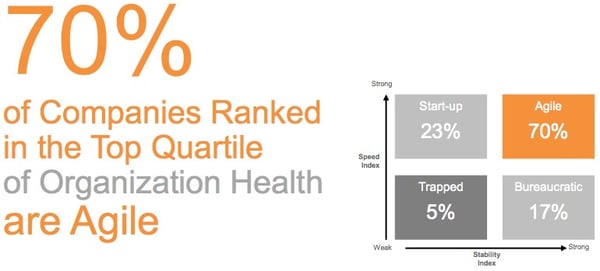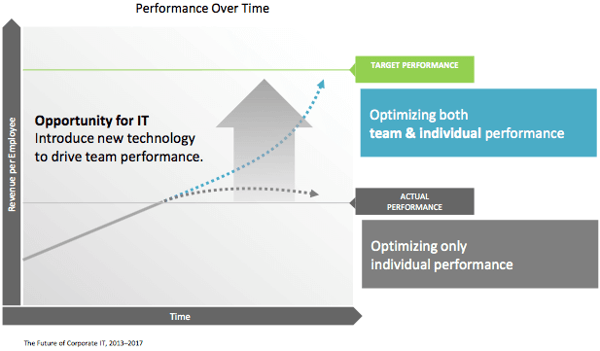Business models are changing and technology is being used unlike ever before to disrupt existing marketplaces; transportation with Uber and Lyft, hotels with Airbnb, retail with Amazon, and music with Spotify and Pandora. Work is also more interconnected than ever—two out of three people say they have to collaborate with others more than in the past to get their job done and 62% of employees now carry three or more devices (e.g., laptop, smartphone, and tablet). The majority of collaboration now takes place with someone who isn't in the same geographic location, or perhaps not even in the same company. As the pace of change in interconnectivity continues to accelerate, what can organizations do to obtain the most benefit?
Disrupt or Be Disrupted
Work is no longer a place we go to, but something we do, collaboration solutions are evolving to reflect this shift. We can work from wherever we are, whether it's at home, in the office, or out on the field. Although we used to do most of our work individually, now we need to bring together agile teams in real-time using rich media. This allows us to gain access to expertise, bring shareholders and stakeholders together, make decisions, and move business processes forward faster and more efficiently. Better collaboration tools take cost and time out of the cycle, which effectively adds margin into the business in the form of principal or shareholder value.
Collaboration can unleash the talent and resources in your organization, which leads to the ability to create new ways to go to market and be a disruptor, even if you're already an industry leader. There will be a 500% increase in information by the year 2020. Organizations need to have an architecture that allows them to leverage all this information in a meaningful way. Today over 60% of organizations offer mobility to workers, and this number will skyrocket to 90% by 2020. We've also seen the move from internal interactions to the leveraging of an ecosystem of partners, suppliers and people outside the organization to drive the business. We're going to see collaborative environments with a 35% increase in innovation and creativity because we now have the ability to access the best of the best, wherever they are and whatever organization they may belong to.
The Rise of Connected Work
The collaboration trends we're seeing are leading to agile organizations that promote the open flow of information, meaning people don't have to spend unnecessary effort looking for collaborators, expertise, or content. Users want to leverage these resources easily so they can bring teams together, make decisions, and make progress in a project. This often involves the new trend of self-forming teams that disperse after getting a task done in a short amount of time. Ultimately, we're moving towards a landscape that's mobile, people-centric, contextual, collaborative, innovative, and customer-driven.
Changing Communication Preferences
It isn't just the way we work that's changing, but also the way people buy in the marketplace. The left hand side of the below table below shows the age of profiled customers and the top row shows their preferred communication method. If your revenue stream depends on a target market comprised of Generation Y/Millennials, picking up the phone to make a call is their fourth choice behind electronic messaging, social media, or smartphone apps. As we look at enhancing our collaboration architectures, we need to make sure that we have a multi-channel strategy because the way our customers want to reach us is changing. In order to keep pace, we must change right along with our customers and meet their needs going forward.

Unified Communication Collaboration Tools Influence Knowledge Retention
If we want to bring teams together to reach their goals quickly, it needs to be done in an environment that provides the highest level of knowledge transfer and retention. Better collaboration tools directly lead to a higher level of execution. A study done by the Human Productivity Lab concluded we only remember 20% of what we hear. (Therefore, an audio-only conference call is not a very productive environment.) By combining audio with supporting written documents, that number goes to 30%. When we're given the ability to watch and listen to a video or web conference, knowledge transfer rates jump all the way up to 70%.
Result-Driven Focus Leads to Agility
If your organization is working on innovating in a customer-driven manner, it will naturally lead to increased profit margins and customer satisfaction. (If you're working on something that isn't driving profit margins and customer sat, you're focusing your efforts in the wrong area.) Don't prioritize how, when, or where someone does their work—instead, look at the result, along with how to reach that result with speed and accuracy. Altogether, this is what creates an agile organization. You must ensure information is easily accessible allowing teams to come together in a single place, working both synchronously and asynchronously. (This kind of work style has led to shared workspaces and the rise of services like Slack and Spark.)
Encourage Experimentation & Function as a Network
It is critical you encourage experimentation, because people won't succeed if they aren't willing to try a new, untested strategy if they carry a fear of failure. How many different light bulb designs did Thomas Edison make before he built one that worked? How many careers did Abraham Lincoln try before he decided upon politics? Give your sales team the ability to talk to an engineer instantly, right from their tablet. If a customer asks a question, they won't have to write it down and disengage from the sale in order to get an answer. Removing this extra time from the sales cycle means higher margins and enhanced shareholder value.
A 2015 McKinsey study titled “Why Agility Pays” concluded 70% of companies in the top quartile of organizational health (in terms of speed and stability) are agile. These are organizations that have collaboration architectures and ecosystems allowing them to leverage expertise and information in faster ways, leading to increased market penetration and business growth. Allow your organization to function as a network of innovation, information, people, and expertise. Instead of looking within your immediate team or location, look throughout the entire organization and beyond. Collaboration is foundational to disruption, marketshare, and margins, which ultimately grow the business.

In an agile organization, conversations move seamlessly from IM to a voice or video call to maximize the level of knowledge transfer and retention. Users have the ability to understand someone's work state and determine if it is a good time to engage them. Regardless of the device someone is using, it is possible to access information and expertise in real-time.
Team Performance is Necessary for Growth
In the past, we would give people the capability to grow their individual performance. Unfortunately, tools and individual effort can only lead to so much value before reaching a plateau. The study depicted below, from a CEB survey of CIO's shows if you invest in optimizing both individual and team performance, it will result in higher overall growth in terms of revenue per employee. By allowing people to access the resources they need in real-time, it will give your organization a significant competitive advantage.

Business Leaders' Top 5 Priorities are Tied to Collaboration
The top five areas on business leaders' minds are:
- Customer Satisfaction - If customers love your company, they will continue to buy from you.
- Cost Control - If you can take costs out of the structure, it results in increased margins and profitability.
- Productivity - Productivity comes from getting the most out of the team by providing the best tools, whether it's the type of workspace or the type of communication technology.
- Engagement - People on the team should feel empowered by communication tools, so they feel valued and able to excel.
- Innovation & Growth - Without constant innovation and growth, companies will eventually become irrelevant. (Look at Smith Corona's typewriters or Kodak for examples of companies that did the right thing for too long, until they lost their place in the market.)
If IT is making a large investment in architecture, it should be tied back to business by driving these top five areas that CEO's say they want the corporation to focus on. By 2018, 60% of IT spend will be decided by the line of business. It's critical to understand what marketing is doing, what R&D is doing, and how sales is going to market so that IT can be closely aligned with the line of business and provide an incredible amount of value.
Let's investigate how you can leverage advanced collaboration tools to impact the top five priorities on business leaders' minds:
1. Improve Customer Satisfaction
As customer expectations increase, maintaining customer satisfaction is an ongoing challenge and a competitive opportunity. Companies want to hold on to their customers so they don't move to one of the many new competitors constantly emerging. A primary collaboration use case is to provide a multichannel customer experience. Because phone calls are Millennials' fourth choice, give them the option to use IM or WebRTC, so they can click a link in the browser to initiate a live video with someone who can provide assistance (without the need for any downloads).
Regardless of the industry or part of the business, harness collaboration to leverage expertise in real-time, shorten the cycle, and drive margins. If someone on your team is interacting with a customer, for instance, give them the ability to instantly leverage remote experts. That way, if the customer asks a difficult question, they can reach out and obtain an accurate answer. On a worksite, a remote expert could look at structural issues. On the manufacturing floor, employees could look at a worn part to determine whether it needs to be replaced. When someone is out on the field with a customer who wants to buy more than usual, they could have an instant discussion with the financing team right from their tablet. That way, they would be able to obtain instant approval for an increased credit limit without even having to leave the room. Taking care of the customer's concern on first contact is a surefire way to increase customer satisfaction, loyalty, and retention.
2. Control Costs
Reduce costs by simplifying technology and giving flexible collaboration options to employees. It doesn't matter how good the solution is—if it isn't easy to use or it isn't always up and running, people aren't going to adopt it. Consolidate your communications infrastructure and create flexible work areas. We've all seen the trend of collaborative workspaces where employees are situated in an open area. (Before that, we had cubicles that were so high, you had to stand up to see if there were other people around you.) Incorporate video into your meetings to obtain a 70% knowledge transfer rate, which goes back to the study done by the Human Productivity Lab. This is the kind of environment that will lead to the highest level of understanding and execution. Support teleworkers and branch offices and allow them to feel like they are part of one big company. No matter where they are within the organization, they should not feel restricted.
3. Enhance Productivity
Accelerate decision making, build trust within and beyond the organization, and promote innovation. CEO's overwhelmingly say that their best asset is their team. Enable meetings with remote participants so that people can come together to make decisions quickly. The concept of presence means that you have the ability to see if someone is on a call, in a meeting, or available to collaborate. According to Gartner, presence can save up to three productivity hours per employee per week. In a 5,000 person organization, that adds up to 250,000 hours of productivity put back into business just by allowing people to understand everyone's work state. For organizations without presence, it becomes necessary to place a call to see if someone is available. Missed calls or waiting for voicemail responses leads to wasted time, while presence allows you to engage the right expertise the first time.
4. Improve Employee Engagement
The more connected your employees feel, the easier it is for them to support the organization's objectives. The emergence of team spaces allows people to conveniently share information and work with people across different time zones because all status updates and documents are located in a centralized repository. Provide employees with events, training, and interaction with other people across the enterprise in a secure, easy way. Users don't want to be restricted to using a specific device; they want to access people and information regardless of the device they are carrying.
5. Support Innovation and Growth
Improve collaboration to accelerate the development of new ideas. Support new products, process improvements, and growth. Continue to look at the marketplace, your product set, and your organization as a whole. The ongoing trend involves collaborating with emerging or external organizations including suppliers, partners, and customers. Whether it's the advertising, financial, or compliance teams, allow everyone to be brought into a situation very quickly with rich media. Shorten design and manufacturing cycle times by facilitating online collaboration. For instance, one of our customers used to send clothing designs from New York to Hong Kong. Once samples were made, they were shipped back to New York for feedback. Now, everything is done from a virtual runway so changes can be made immediately, with no need for shipping. Not only is it possible to shorten design and manufacturing, but also reduce the time to hire, sell, and market. By performing these functions faster and more efficiently, you will continue to drive revenue.
New ways to work fundamentally impact how a business operates, which adds velocity to decision making. When leaders join together in real-time to make a decision that affects a customer, event, or market penetration plan, they are able to execute at a higher level. Executive and technical talent can be leveraged anytime, anywhere.
For further information, view the full webinar below:




